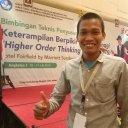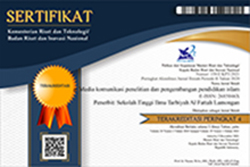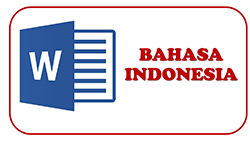PROSES BERPIKIR SISWA MADRASAH ALIYAH DALAM MEMBUAT PETA KONSEP TURUNAN DİTİNJAU DARI GAYA BELAJAR VISUAL, AUIDITORI DAN KINESTETIK
Abstract
This research aims to describe the thinking process of students in creating concept maps based on visual, auditory and kinesthetic learning styles.This research is descriptive research with qualitative approach. The subjects consisted of 3 students based on the learning style questionnaire analysis. Data collection techniques are job-based interviews.The results showed that there are differences in students' thinking processes in creating concept maps. The three subjects perform the stage of creating a concept map completely but there are differences on how to make it. This happens because subjects with an auditory learning style can’t make a cross link so the resulting concept maps are different.The results of this research can be used as an alternative in developing learning by concept map method.
Downloads
References
Anderson, T. H and Armbruster, B. B.(1984). Studying, In P.D. Pearson Ed Handbook of Reading Research. New York: Longman.
Buzan, T. (2007). Buku Pintar Mind Map. Jakarta: Gramedia Pustaka Utama.
De Porter, B. and Hernacki, M. (2004).Quantum Learning. Bandung : Kaifa
Gaddy, M. L.(1998).Reading and Studying from High Lighted Text: Memory for Information Highlighted by Others Paper Presented at The annual Meeting of The American Educational Research Association. San Diego: CA.
Isroil, A., Budayasa, I.K., dan Masriyah. (2017). Profil Berpikir Siswa SMP dalam Menyelesaikan Masalah Matematika Ditinjau dari Kemampuan Matematika. Jurnal Review Pembelajaran Matematika, 2(2), 93-105.
Jones,V. (2006).Cognitive Processes During Problem Solving of Middle School Students with Different Levels of Mathematics Anxiety and Self-estem. FL: Florida State University.
Kusaeri, K. (2017). Terbentuknya Konsepsi Matematika pada Diri Anak dari Prespektif Teori Reifikasi dan APOS. Jurnal Pendidikan Matematika, I(2), 101-105.
Limbach, B. and Waugh, W.(2005). Developing Higher Level Thinking. Journal of Instructional Pedagogiesp 1-9
Marpaung, Y. (1999). Mengejar ketertinggalan kita dalam pendidikan matematika, mengutamakan proses berpikir dalam pembelajaran matematika. (Makalah disampaikan dalam upacara pembukaan program S3 Pendidikan Matematika Universitas Negeri Surabaya Tanggal 10 November 1999).
Mayer R E. (1983).Thinking, Problem Solving, Cognition. USA: W. H Freeman and Company
Novak, J. (2002). Meaningful learning: the essential factor for conceptual change in limited or appropriate propositional hierarchies (LIPHs) leading to empowerment of learners. Science Education, 86(4), 548-571.
Panjaitan, B. (2013). Proses Kognitif Siswa dalam Menyelesaikan Masalah Matematika. Jurnal Ilmu Pendidikan 19(1) p 17-25
Ruggiero, V. R. (2012).Beyond Fellings a Guide to Critical Thinking. New York: TheMcGrawe- Hill Companies.Inc.
Santrock J W. (2011).Educational Psychology Fifth Editon. New York: TheMcGrawe-Hill Companies.Inc.
Strenberg, R. J. (2006). Cognitive Psychology 4th ed. Belmont CA: ThomsonWadsworth.
Sukiyanto, S. (2020). Munculnya Kesadaran Metakognisi Dalam Menyelesaikan Masalah Matematika. Aksioma: Jurnal Program Studi Pendidikan Matematika.9(1). 126-132.





.png)










